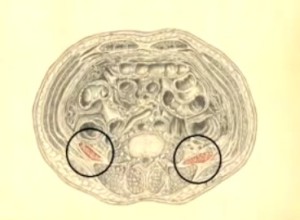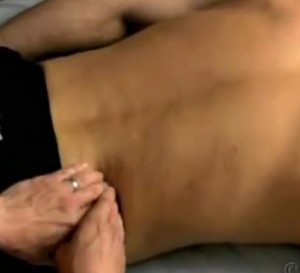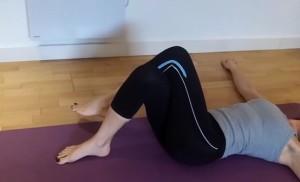The quadratus lumborum is a large flat muscle which occurs over a large section of the middle and lower back. One is present on each side of the back. The muscle is quadrilateral and irregular in shape; it is narrow at the base and broader at the top. It begins in the middle part of the back and joins the vertebrae of the middle and lower back as well as the lowest rib. It ends at the iliac crest where it joins the hip bone. The innervation is through the lumbar and subcostal nerves while the lumbar arteries provide the blood supply.
The quadratus lumborum muscle has two main functions, i.e., to flex the trunk to each side of the body and to keep the lowest rib in a steady position when breathing. It is also used when bending over to the side to pick up an object. The muscle also gets activated when standing, sitting, or walking. Due to the involvement of the muscle in a variety of daily activities, it can often cause back pain, thereby making it a common area of physical therapy.
Quadratus lumborum pain
- The quadratus lumborum muscle joins to the pelvis as well as the spine and is thus involved in varied routine activities. Many cases of lower back pain are therefore associated with the quadratus lumborum. The muscle’s unique position also means that it takes in the added pressure exerted by the other muscles, leading to fatigue of the quadratus lumborum. If the muscle is kept in a loaded and over-stretched position for prolonged periods, then ultimately it may begin to spasm and culminate in pain.
- There are many stretching exercises of the quadratus lumborum which can help prevent pain in the back. It will also decrease the chances of recurrent spasms and/or muscle injuries.
- Besides exercises for strengthening and stretching the quadratus lumborum muscle, patients may also alleviate the associated pain via massages, warm or cold compresses, and myofascial therapies.
Quadratus lumborum stretching exercises
A few stretching exercises which need to be a part of any comprehensive rehabilitation program for quadratus lumborum problems are listed below:
- Hooklying stretch
- Lie on the back on a bed or on the floor. Support your neck with a pillow if you want. Let the hands rest on the stomach. Bend the knees while making sure that the feet keep touching the floor.
- Cross the left leg over the right and then slowly lower the knees to the left till the left lower back and hips feel slightly stretched. Ensure that the shoulders are on the bed. Maintain the position for about 5 seconds.
- Get the legs back into the original position at the center. Now, switch the legs and repeat the above process so that right hips and lower back get stretched.
- Side plank
- It is an isometric exercise that not only stretches the quadratus lumborum, but also targets the external and internal oblique muscles.
- Lie on back on the floor or on a bed. Place one leg above the other and the lower forearm on the floor in line with the shoulders. Tighten the abdomen muscles and elevate the hip above the floor. Ensure that the body is in a straight position; the hips should not be above the waist or sag below it. Hold the position for around 15 seconds. Do 5 repetitions 5 times a day.
- Sitting side bends
- Sit in a comfortable place with a straight spine. Use a stretching strap or a towel and place one end in the right hand and the other end under the right foot. Now bend sideways towards the right side as much as you can. This with strengthen and stretch the left quadratus lumborum.
- Now, try to sit up in a straight position, breathe normally, while simultaneously contracting the left muscle isometrically for about 6 seconds.
- After the contraction, breathe, relax, and intensify the stretching by bending sideways towards the right.
- Kneeling stretch
- Kneel before a sturdy table, chair, or stool and then get into an all-fours position.
- Now, with your right hand grab the left leg of the chair, at shoulder height, with the palms facing towards the right side. The body will slightly twist towards the left.
- Now, diagonally shift towards the right so that the right side of the body slightly curves from the arm to the hip. Ensure that the left hand remains placed firmly on the floor. Hold the position for about 5 seconds.
- Slowly come back to the original all-fours position in reverse. Now repeat the stretch with the left hand for the left side of quadratus lumborum.
- Asymmetric kettlebell carry
- Hold a kettlebell in one arm, bend the elbows, raise the kettlebell to the level of the shoulders, and let it rest there. Now, walk around for 10 to 12 steps, ensuring that the spine remains straight when walking. In this, the quadratus lumborum muscles on the opposite side of the kettlebell will stretch and strengthen.



